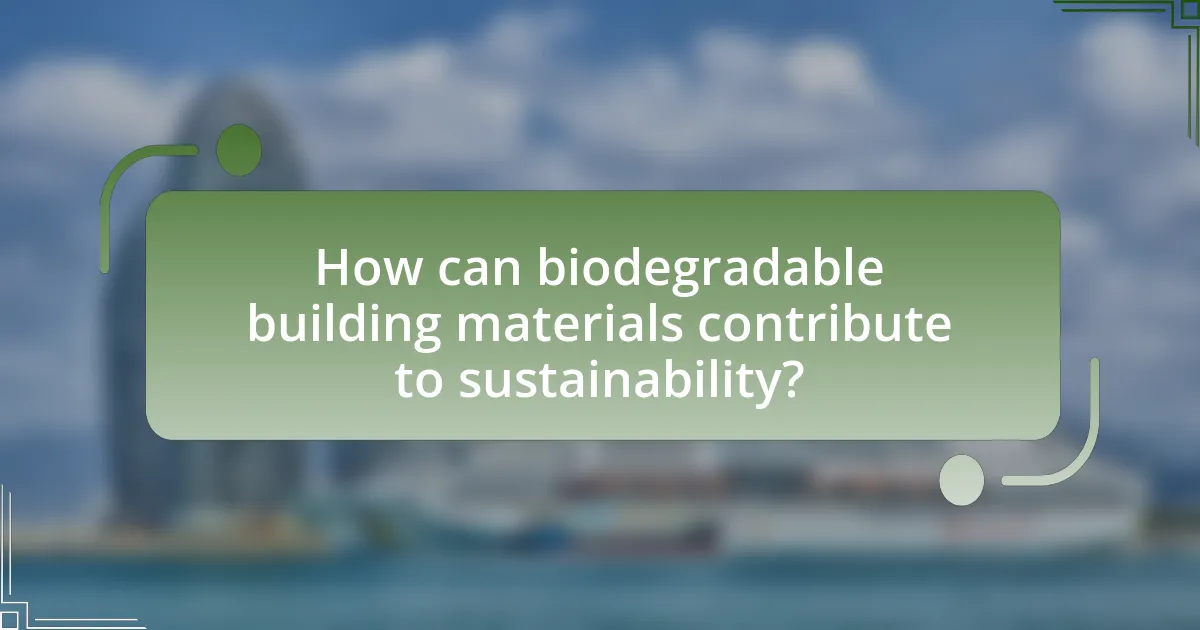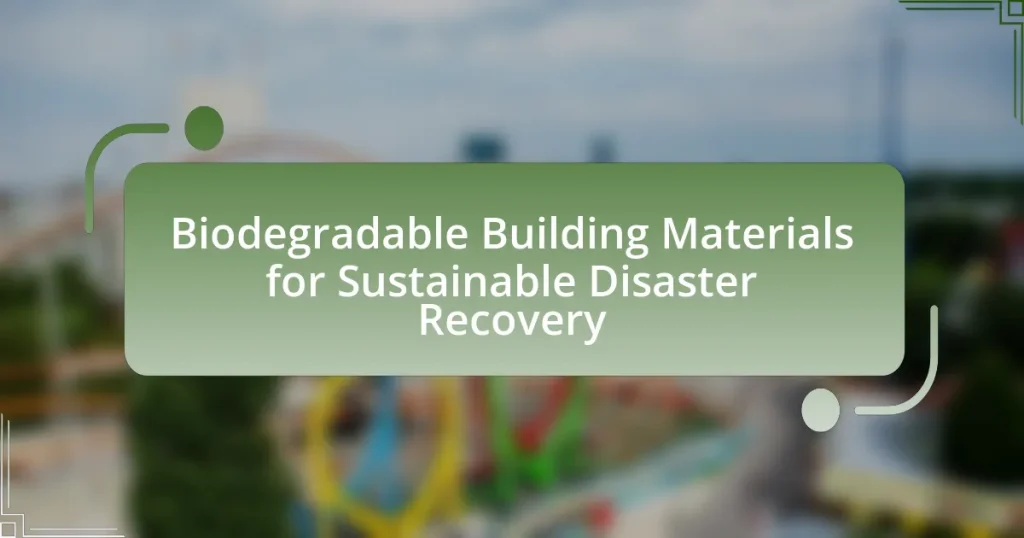Biodegradable building materials are construction materials that decompose naturally, reducing environmental impact and promoting sustainability. This article explores the differences between biodegradable and traditional materials, highlighting key characteristics such as renewability and low environmental impact. It discusses various types of biodegradable materials, their role in disaster recovery, and the economic and environmental benefits they offer. Additionally, the article addresses challenges in implementation, misconceptions, and best practices for effective use in construction, emphasizing the importance of sustainability in rebuilding efforts.

What are Biodegradable Building Materials?
Biodegradable building materials are construction materials that can decompose naturally through biological processes, minimizing environmental impact. These materials, such as bamboo, straw, and certain types of bioplastics, are designed to break down over time, returning nutrients to the soil and reducing landfill waste. Research indicates that using biodegradable materials can significantly lower carbon footprints and promote sustainability in construction practices, aligning with eco-friendly building standards and disaster recovery efforts.
How do biodegradable building materials differ from traditional materials?
Biodegradable building materials differ from traditional materials primarily in their ability to decompose naturally and return to the environment without causing harm. Traditional materials, such as concrete and steel, are often non-biodegradable and can persist in landfills for centuries, contributing to environmental degradation. In contrast, biodegradable materials, like bamboo, straw, and certain bioplastics, are designed to break down within a specific timeframe, typically within a few months to a few years, depending on environmental conditions. This characteristic not only reduces waste but also minimizes the carbon footprint associated with construction and demolition processes. Studies indicate that using biodegradable materials can significantly lower greenhouse gas emissions compared to traditional building materials, supporting sustainable practices in construction and disaster recovery efforts.
What are the key characteristics of biodegradable building materials?
Biodegradable building materials are characterized by their ability to decompose naturally and return to the environment without causing harm. These materials typically include organic substances such as wood, bamboo, straw, and certain bioplastics, which break down through microbial activity over time. The key characteristics include renewability, as they are sourced from sustainable resources; low environmental impact, since they reduce landfill waste and pollution; and energy efficiency, as their production often requires less energy compared to conventional materials. Additionally, biodegradable building materials can enhance soil health when they decompose, contributing to a circular economy in construction.
Why is biodegradability important in construction?
Biodegradability is important in construction because it reduces environmental impact and promotes sustainability. Biodegradable materials decompose naturally, minimizing waste in landfills and lowering pollution levels. For instance, traditional construction materials like concrete and steel can take centuries to break down, while biodegradable alternatives, such as hempcrete or bamboo, can return to the ecosystem within a few years. This rapid decomposition helps restore natural habitats and supports circular economy principles, where materials are reused and recycled rather than discarded. Additionally, using biodegradable materials can enhance resilience in disaster recovery by allowing for quicker rebuilding processes that align with ecological restoration efforts.
What types of biodegradable building materials are available?
Biodegradable building materials include options such as bamboo, straw bales, hempcrete, mycelium, and recycled paper products. Bamboo is a fast-growing grass that can be harvested sustainably and used for structural applications. Straw bales provide excellent insulation and are often used in wall construction. Hempcrete, made from hemp fibers and lime, offers durability and insulation while being carbon-negative. Mycelium, the root structure of fungi, can be grown into bricks and is fully compostable. Recycled paper products can be processed into insulation and wall panels, reducing waste. These materials contribute to sustainable construction practices by minimizing environmental impact and promoting resource efficiency.
What are the most common natural materials used in construction?
The most common natural materials used in construction are wood, stone, clay, and straw. Wood is widely utilized for its strength and versatility, making it a primary choice for framing and flooring. Stone, known for its durability and aesthetic appeal, is often used in foundations and facades. Clay is primarily used in the form of bricks and tiles, providing excellent thermal properties. Straw, particularly in straw bale construction, offers insulation and is an eco-friendly option. These materials are favored not only for their availability but also for their sustainability and low environmental impact in construction practices.
How are synthetic biodegradable materials developed?
Synthetic biodegradable materials are developed through a combination of polymer chemistry and biotechnological processes. Researchers create these materials by synthesizing polymers that can break down into non-toxic components in the environment, often using renewable resources such as starch, cellulose, or polylactic acid (PLA). For instance, PLA is derived from fermented plant starch, which undergoes polymerization to form a biodegradable plastic. Studies have shown that these materials can decompose within a few months to a few years, depending on environmental conditions, thus supporting sustainable practices in construction and disaster recovery.
What role do biodegradable building materials play in disaster recovery?
Biodegradable building materials play a crucial role in disaster recovery by providing sustainable and environmentally friendly options for reconstruction. These materials, such as bamboo, straw bales, and mycelium, reduce waste and minimize the environmental impact of rebuilding efforts. For instance, using biodegradable materials can help restore ecosystems by allowing for natural decomposition, which enriches the soil and promotes regrowth. Additionally, studies have shown that incorporating such materials can lower carbon emissions associated with traditional construction methods, thereby contributing to a more sustainable recovery process.
How can these materials expedite the rebuilding process after a disaster?
Biodegradable building materials can expedite the rebuilding process after a disaster by enabling faster construction and reducing waste. These materials, such as hempcrete and bamboo, are lightweight and easy to work with, allowing for quicker assembly compared to traditional materials. Additionally, their natural properties often require less energy for production and can be sourced locally, minimizing transportation delays. For instance, a study by the University of Cambridge found that using sustainable materials can reduce construction time by up to 30%, facilitating a more efficient recovery process in disaster-affected areas.
What are the environmental benefits of using biodegradable materials in recovery efforts?
Biodegradable materials in recovery efforts significantly reduce environmental impact by minimizing waste and pollution. These materials decompose naturally, returning nutrients to the soil and preventing long-term landfill accumulation. For instance, studies indicate that using biodegradable plastics can reduce greenhouse gas emissions by up to 68% compared to traditional plastics, as they break down more efficiently in natural environments. Additionally, biodegradable materials help preserve biodiversity by reducing the risk of harmful chemicals leaching into ecosystems, thus supporting healthier habitats.

How can biodegradable building materials contribute to sustainability?
Biodegradable building materials contribute to sustainability by reducing waste and minimizing environmental impact during construction and demolition. These materials, such as bamboo, straw, and mycelium, decompose naturally, returning nutrients to the soil and preventing landfill accumulation. According to a study published in the Journal of Cleaner Production, using biodegradable materials can decrease carbon emissions by up to 50% compared to traditional materials like concrete and steel. This reduction in emissions, along with the sustainable sourcing of biodegradable materials, supports a circular economy and promotes ecological balance.
What are the long-term benefits of using biodegradable materials in construction?
The long-term benefits of using biodegradable materials in construction include reduced environmental impact, enhanced sustainability, and improved resource efficiency. Biodegradable materials decompose naturally, minimizing landfill waste and pollution, which contributes to a healthier ecosystem. For instance, studies show that using materials like bamboo and hemp can significantly lower carbon emissions compared to traditional construction materials, as they sequester carbon during their growth. Additionally, biodegradable materials often require less energy to produce and can be sourced locally, further reducing transportation emissions and supporting local economies. This shift not only promotes sustainable building practices but also aligns with global efforts to combat climate change and resource depletion.
How do these materials reduce waste and pollution?
Biodegradable building materials reduce waste and pollution by decomposing naturally, thus minimizing landfill contributions and harmful emissions. These materials, such as bamboo, straw, and recycled wood, break down over time, returning nutrients to the soil and preventing long-term environmental degradation. For instance, a study published in the Journal of Cleaner Production found that using biodegradable materials can reduce construction waste by up to 30%, significantly lowering the carbon footprint associated with traditional building materials.
What impact do biodegradable materials have on carbon footprint?
Biodegradable materials significantly reduce carbon footprint by decomposing naturally and releasing fewer greenhouse gases compared to traditional materials. When biodegradable materials break down, they typically produce carbon dioxide and methane, but the overall emissions are lower than those from synthetic materials, which often release more carbon during production and disposal. For instance, a study published in the journal “Environmental Science & Technology” found that using biodegradable plastics can reduce greenhouse gas emissions by up to 50% compared to conventional plastics. This reduction in emissions contributes to a smaller carbon footprint, supporting sustainability efforts in construction and disaster recovery.
Why is sustainability crucial in disaster recovery efforts?
Sustainability is crucial in disaster recovery efforts because it ensures that rebuilding processes do not compromise environmental integrity while promoting resilience against future disasters. Sustainable practices, such as using biodegradable building materials, minimize waste and reduce the carbon footprint associated with reconstruction. For instance, the use of materials like bamboo or recycled plastics can significantly lower emissions compared to traditional construction methods. Furthermore, sustainable recovery fosters community resilience by integrating local resources and knowledge, which has been shown to enhance recovery speed and effectiveness, as evidenced by case studies in post-hurricane rebuilding efforts in the Caribbean.
How can sustainable practices improve community resilience?
Sustainable practices can improve community resilience by enhancing environmental health, reducing resource dependency, and fostering social cohesion. Implementing sustainable practices, such as using biodegradable building materials, minimizes waste and pollution, which in turn supports healthier ecosystems. For example, communities that adopt green building techniques often experience lower energy costs and reduced vulnerability to climate-related disasters. Research indicates that sustainable urban planning can lead to a 30% reduction in greenhouse gas emissions, thereby mitigating climate change impacts that threaten community stability. Furthermore, engaging community members in sustainable initiatives strengthens social ties and collective problem-solving, which are critical for effective disaster response and recovery.
What are the economic advantages of sustainable disaster recovery?
Sustainable disaster recovery offers significant economic advantages, primarily through cost savings, job creation, and increased resilience. By utilizing biodegradable building materials, communities can reduce waste disposal costs and lower the expenses associated with rebuilding efforts. For instance, studies indicate that sustainable practices can decrease reconstruction costs by up to 30% compared to traditional methods. Additionally, sustainable recovery initiatives often lead to the creation of green jobs, which can stimulate local economies and enhance community engagement. Furthermore, investing in resilient infrastructure minimizes future disaster-related losses, with research showing that every dollar spent on disaster preparedness can save up to six dollars in recovery costs. These factors collectively underscore the economic benefits of adopting sustainable disaster recovery strategies.

What challenges exist in implementing biodegradable building materials?
Implementing biodegradable building materials faces several challenges, including performance limitations, cost factors, and regulatory hurdles. Performance limitations arise because many biodegradable materials may not meet the durability and strength requirements necessary for construction, particularly in disaster recovery scenarios where resilience is critical. Cost factors are significant as biodegradable materials often have higher production costs compared to traditional materials, which can deter widespread adoption. Regulatory hurdles exist due to a lack of established standards and codes for biodegradable materials, complicating their acceptance in the construction industry. These challenges hinder the integration of biodegradable materials into sustainable building practices, particularly in contexts requiring rapid recovery from disasters.
What are the common misconceptions about biodegradable materials?
Common misconceptions about biodegradable materials include the belief that all biodegradable products decompose quickly and safely in any environment, and that they do not contribute to pollution. In reality, the decomposition rate of biodegradable materials varies significantly based on environmental conditions such as temperature, moisture, and microbial activity. For instance, some biodegradable plastics can take years to break down in landfills where conditions are not conducive to decomposition. Additionally, while biodegradable materials are designed to break down, they can still release harmful substances during the process, contributing to environmental pollution if not managed properly. Studies have shown that improper disposal of biodegradable materials can lead to methane emissions, a potent greenhouse gas, further complicating their perceived environmental benefits.
How do performance concerns affect the adoption of biodegradable materials?
Performance concerns significantly hinder the adoption of biodegradable materials due to their perceived limitations in durability and functionality compared to conventional materials. Many stakeholders, including manufacturers and consumers, worry that biodegradable options may not withstand environmental stresses, leading to premature failure in applications such as construction and packaging. For instance, studies have shown that certain biodegradable plastics can degrade under specific conditions, which raises concerns about their reliability in long-term use. This skepticism is supported by research indicating that while biodegradable materials can be effective in reducing waste, their mechanical properties often do not match those of traditional materials, thus affecting their acceptance in critical applications like disaster recovery where structural integrity is paramount.
What regulatory hurdles must be overcome for wider use?
Regulatory hurdles that must be overcome for wider use of biodegradable building materials include compliance with building codes, environmental regulations, and safety standards. Building codes often require materials to meet specific performance criteria, which biodegradable options may not currently satisfy. Environmental regulations can impose restrictions on the sourcing and disposal of materials, complicating their adoption. Additionally, safety standards related to fire resistance, structural integrity, and durability must be addressed to ensure that these materials are viable alternatives in construction. For instance, the International Building Code outlines requirements that biodegradable materials must meet to be considered safe for use in construction projects.
How can stakeholders overcome these challenges?
Stakeholders can overcome challenges in utilizing biodegradable building materials for sustainable disaster recovery by fostering collaboration among industry players, policymakers, and researchers. This collaboration can lead to the development of standardized practices and guidelines that enhance the adoption of these materials. For instance, partnerships between construction companies and material scientists can facilitate innovation and improve the performance of biodegradable options. Additionally, stakeholders can advocate for government incentives that promote the use of sustainable materials, as evidenced by programs in countries like Germany, where subsidies have successfully increased the market share of eco-friendly building products. By leveraging these strategies, stakeholders can effectively address the barriers to implementing biodegradable materials in disaster recovery efforts.
What role do education and awareness play in promoting biodegradable materials?
Education and awareness are crucial in promoting biodegradable materials by informing individuals and communities about their environmental benefits and practical applications. Increased knowledge leads to informed consumer choices, encouraging the adoption of biodegradable options over conventional materials. For instance, studies show that communities with educational programs on sustainability are more likely to utilize biodegradable products, resulting in reduced landfill waste and lower carbon footprints. Furthermore, awareness campaigns can highlight the lifecycle advantages of biodegradable materials, such as their ability to decompose naturally, thus fostering a culture of sustainability and responsible consumption.
How can collaboration among industries facilitate the use of these materials?
Collaboration among industries can facilitate the use of biodegradable building materials by pooling resources, expertise, and technology to enhance material development and application. For instance, partnerships between construction firms and material scientists can lead to innovative solutions that improve the performance and sustainability of these materials. Additionally, joint ventures can streamline supply chains, making it easier to source and distribute biodegradable materials, thereby increasing their adoption in disaster recovery efforts. Evidence of this can be seen in initiatives like the Circular Economy in Construction, where multiple stakeholders work together to promote sustainable practices, resulting in a 30% reduction in waste and improved resource efficiency in building projects.
What best practices should be followed when using biodegradable building materials?
When using biodegradable building materials, it is essential to prioritize sourcing materials that are certified and tested for biodegradability. This ensures that the materials will decompose effectively without harming the environment. Additionally, proper design and construction techniques should be employed to enhance the durability and lifespan of these materials, minimizing the need for replacements.
Moreover, integrating local materials can reduce transportation emissions and support local economies, aligning with sustainable practices. It is also crucial to educate stakeholders, including builders and clients, about the benefits and limitations of biodegradable materials to ensure informed decision-making.
Research indicates that using biodegradable materials can significantly reduce waste in construction, with studies showing that they can lower carbon footprints by up to 30% compared to traditional materials. This evidence supports the adoption of best practices in the use of biodegradable building materials for sustainable disaster recovery.
How can builders ensure the effective use of biodegradable materials in construction?
Builders can ensure the effective use of biodegradable materials in construction by selecting materials that meet environmental standards and integrating them into design and construction processes. This involves sourcing certified biodegradable products, such as bamboo, straw, or mycelium-based materials, which have been proven to decompose naturally and reduce environmental impact. Additionally, builders should implement training programs for construction teams to understand the properties and benefits of these materials, ensuring proper handling and installation techniques. Research indicates that using biodegradable materials can significantly lower carbon footprints; for example, a study published in the Journal of Cleaner Production found that incorporating natural materials can reduce greenhouse gas emissions by up to 30% compared to traditional materials.
What are the maintenance considerations for biodegradable structures?
Maintenance considerations for biodegradable structures include monitoring material degradation, ensuring structural integrity, and managing environmental exposure. Biodegradable materials, such as those derived from natural fibers or polymers, can deteriorate over time due to moisture, UV radiation, and biological factors. Regular inspections are essential to assess the condition of these materials and identify any signs of wear or failure. Additionally, maintenance practices may involve applying protective coatings or treatments to enhance durability and extend the lifespan of the structure. Research indicates that proactive maintenance can significantly improve the performance and longevity of biodegradable building materials, making them viable for sustainable disaster recovery efforts.




